Attika
Attika (Originalregel)
Préparation du Jeu
2 à 4 joueurs peuvent participer à une partie en valant /join Démarrez le jeu avec /start Il est aussi possible d'utiliser les raccourcis de l'outil Jeu.
Le jeu et son objectif
Chaque joueur se charge de la construction d'une ville-Etat. Le temple, le théâtre et l'oracle, un port avec des navires, vignoble, viticulteurs et beaucoup dautres doivent trouver leur place sur la péninsule grecque. Très rapidement le terrain est occupé et il faut se protéger des adversaires et les empêcher de sétendre et s'assurer des terrains libres.
Construire est toutefois coûteux. Celui qui veut épargner, doit utiliser les resources naturelles du pays ou utiliser les bonus des séries, en mettant ses bâtiments convenables les uns à coté des autres.
Le vainqueur celui qui le premier :
- Pose ses 30 bâtiments sur le plateau de jeu
ou
- relie deux sanctuaires à laide de ses propres bâtiments.
Son tour de jeu
A son tour le joueur choisit entre les posibilités suivantes :
- 2x Piocher und bâtiment dans une de ses piles
- 3x Construire à partir de sa réserve
Piocher

Le joueur clique sur une de ses quatre piles de bâtiments. Le bâtiment pioché est alors affiché à droite à côté de la pioche. Si le joueur veut construire ce bâtiment (cf. règles de construction), il clique sur les matières premières nécessaires dans le coin supérieur gauche de lécran et peut alors mettre immédiatement le bâtiment sur le plateau. Autrement, il doit entreposer le bâtiment dans sa réserve.
Cette action peut être répétée deux fois.
Construire
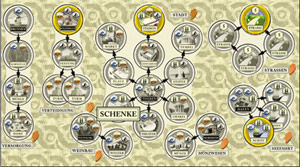
Le joueur prend un bâtiment de son choix de sa réserve (on l'ouvre en cliquant sur son nom), ensuite il clique sur les matières premières nécessaires dans le coin supérieur gauche de lécran et peut alors mettre immédi plateau le bâtiment sur le
Cette action peut être répétée trois fois.
Piocher et construire dans un même tour nest pas possible.

Ce symbols avec la flèche verte permet de mettre le bâtiment pioché dans sa réserve.
Piocher des matières premières

Un joueur peut renoncer à tout ou partie des actions piocher ou construire. Pour chaque pioche ou construction non réalisée, il reçoit une matière première. Pour cela il clique sur la flèche rouge en haut à gauche, et le tour du joueur ce termine. (Si le joueur navait fait aucune action, il pioche 3 cartes)

Une autre possibilité existe s'il est en possession dau moins une Amphore (voir plus bas). Il peut alors également transformer ses autres points d'action avec ce symbols bleu en matières premières, cependant le tour de jeu nend pas fin. Si les matières premières souhaitées n'ont pas été tirées, on doit maintenant utiliser encore l'Amphore pour tirer d'autres cartes de matières premières. Des actions différentes ne sont toutefois plus possibles dans ce tour de jeu.
Règles de construction
Où doivent être placés les bâtiments ?
Les bâtiments peuvent être construits sur chaque hexagone inoccupé du plateau, indépendamment du fait de savoir si un Symbole de paysage est dessiné dessus ou non. Ils ne peuvent pas être construits sur des hexagones sur lesquels des bâtiments se trouvent déjà.
Coûts de construction :

Les coûts de construction d'un bâtiment sont marqués sur la tuile elle-même et aussi dans la réserve. Tous les symboles de matières premières se trouvant sur lhexagone de construction et/ou les hexagones inoccupés adjacents sont utilisés en premier (et ne seront plus à payer). Le reste doit être payé par le joueur en cliquant sur ses matières premières en haut à gauche de lécran.
Deux matières premières identiques forment un Joker et peuvent ainsi remplacer une autre matière première !
Les séries logiques de construction (construire gratuitement)
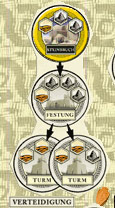
Les frais de base pour la construction sont supprimés complètement, si l'on respecte lordre des séries.
Les flèches dans la réserve déterminent lordre de construction à respecter :
- Le bâtiment, point de départ de la flèche, doit déjà se trouver sur le plateau de jeu.
- Si le joueur construit le bâtiment pointé par la flèche sur un hexagone adjacent au bâtiment origine de la flèche, il peut construire gratuitement.
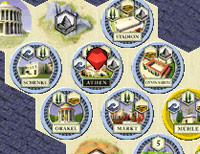
Une pierre précieuse rouge indique toujours, à côté de quel bâtiment on devrait construire son bâtiment actuel, afin que lordre de la série soit respecté (et donc la construction gratuite).
Pour la construction d'une route, un joueur doit payer cinq matières premières de son choix, diminué du nombre de symboles de paysage sur lhexagone de construction et sur les hexagones limitrophes.
Les frais pour une route ("street") sont nuls, si elle est construite sur un hexagone adjacent à une autre route de même couleur.
On ne peut pas construire gratuitement dans les cas suivants :
- sens inverse de la flèche : si on a déjà construit une tour ("Turm") on ne peut pas construire gratuitement la forteresse ("Festament").
- bâtiments manquants : on a la carrière ("Steinbruch"), mais pas la forteresse, la construction de la tour est payante.
- mauvaise couleur de joueur : On ne construit gratuitement qu'à la suite dune série de SA couleur.
- Bâtiment principal (écrit en blanc sur fond noir) : un bâtiment principal doit toujours être payé. Les bâtiments qui débutent une série se trouvent pour chaque joueur dans la pile gauche.
Qu'est une agglomération ?
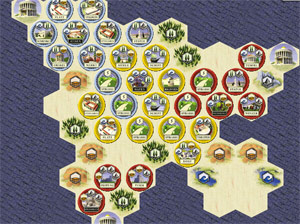
Un ou plusieurs bâtiments d'une couleur forment une agglomération. Le joueur fonde une nouvelle agglomération quand il construit un bâtiment, qui nest pas adjacent à un bâtiment de sa couleur déjà existant (ici dans l'image il y en a deux rouges, une jaune et une bleue).
Si une nouvelle agglomération est fondée, en plus des frais de base du bâtiment, il paye des frais d'agglomération supplémentaire. Par agglomération que le joueur a déjà sur le plan, il doit payer une matière première de son choix de son stock. La troisième agglomération d'un joueur coûte ainsi deux matières premières de plus.
Par un raccordement ultérieur des agglomérations celles-ci peuvent fusionner et réduire dans le cours de jeu les frais de nouvelles agglomérations.
amphoresis
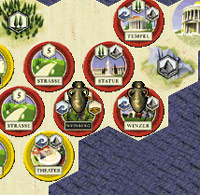
Chaque bâtiment appartient à une des 7 séries thématiques (comme p. ex. défense ou navigation). Celui qui construit ses séries de façon à ce que tous les bâtiments d'une série soient adjacents, reçoit une amphore, avec laquelle il peut prolonger à un moment favourable son tour de jeu.
Quels bâtiments font partie d'une série ?
Dans la réserve, les bâtiments d'une série sont mis en évidence. Si un joueur réussit à construire les bâtiments sur le plateau de jeu de telle sorte qu'ils soient tous adjacents, il reçoit une Amphore comme récompense, qu'il peut utiliser d'emblée.
Si le stock damphore est épuisé (15 amphores), le joueur reçoit une matière première en remplacement.
Prolonger son tour de jeu

Pour utiliser une amphore à la fin de son tour, le joueur clique sur les amphores sur la gauche de son nom. Son tour de jeu est alors prolongé. Le nombre des actions encore existantes est rappelé dans les parenthèses derrière son nom.
Dès qu'un joueur possède au moins une amphore qu'il ne veut pas utiliser pendant son tour, il doit cliquer en haut à gauche à la fin de son tour sur la flèche rouge pour passer. Attention: on oublie facilement ce détail !
Etendre le plateau de jeu
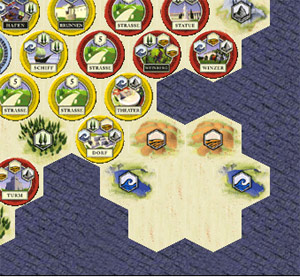
Si un joueur pioche le dernier bâtiment dune de ses quatres, il joue d'abord le bâtiment découvert comme d'habitude en le construisant sur le plateau ou en le posant dans sa réserve. Ensuite, il doit étendre le plateau de jeu. Avec un clic droit avec la souris, le joueur peut tourner le morceau de plateau comme il le souhaite, puis avec un clic gauche il pose le morceau là où il le désire.
Où peut-il le poser?
Le joueur doit mettre le morceau de telle sorte qu'il touche au moins un autre morceau ou un des Sanctuaires. Il peut ainsi se former des espaces vides.
Radar
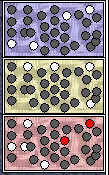
Les images dans le coin en haut à droite sont des aides de jeu. Le joueur peut voir les réserves de tous les joueurs représentées en petit (il est dagrandir celles-ci). Ainsi, le joueur expérimenté peut surveiller la situation de jeu.
Les couleurs signifient :
- rouge : le bâtiment est déjà construit
- Vert : le bâtiment est actuellement dans la main du joueur
- blanc: le bâtiment est dans la réserve
- gris: le bâtiment est encore dans une des piles de pioche
Qu'a t'on au début du jeu ?
Au début de la partie, chaque joueur possède un bâtiment principal et trois autres bâtiments dans sa réserve. Les bâtiments principaux restants sont dans la pile gauche, les autres bâtiments dans les trois autres piles.

